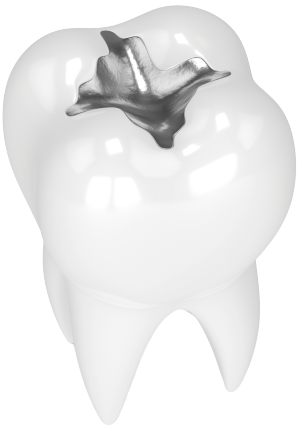As one of the most common procedures in restorative dentistry, treating dental caries, more commonly known as cavities, is important because they are the single most common dental issue in America. Most citizens have had at least 1 by the time they reach adulthood. Fortunately, they are simple enough to treat, and possibly even easier to prevent. A dental filling can treat cavities easily within an hour-long appointment. And by visiting your dentist for regular cleanings and exams every 6 months, we can help you prevent cavities altogether.

At JAX Dental Studio, our dental filling service offers comprehensive solutions for treating tooth decay and preventing further damage. We provide multiple filling options, including composite (tooth-colored), ceramic, gold, and silver amalgam fillings. Our approach focuses on preserving your natural tooth structure while addressing cavities and preventing future decay. Each filling is carefully matched to your tooth color and shaped to restore proper function and appearance. Whether you need a small cavity filled or want to replace old, worn-out fillings, our treatments may help protect your dental health and maintain a beautiful, healthy smile.
Cavities don’t usually hurt. Toothaches are more commonly a symptom of a tooth infection.
First, your mouth will be numbed using local anesthesia. Your dentist will spray your gum with a numbing agent, and use a needle to numb the nerves near the treatment area. This ensures you won’t feel any pain or discomfort throughout the treatment process.
Next, your dentist will use a dental drill to remove decayed enamel and damaged material from your tooth. Then, the tooth will be cleaned and disinfected to prepare it for your filling.
Your dentist will fill your tooth and restore its structure with a tooth-compatible material like dental resin or metal-amalgam. Once the tooth has been filled, the filling will be trimmed and adjusted to ensure that it matches your natural bite and feels comfortable.
Comprehensive dental care accessible to all families regardless of insurance type or coverage limitations.

When Maria received her first dental filling at age 16, she assumed it would last forever. Twenty years later, sitting in Dr. Poblenz’s chair at JAX Dental Studio, she learned that fillings have varying lifespans depending on several key factors. Understanding how long your dental fillings last can help you plan for future dental care and maintain optimal oral health.
The lifespan of dental fillings depends primarily on the material used and your individual oral health habits. Different filling materials offer distinct advantages and longevity expectations:
Tooth-colored dental fillings are an ideal way to fill cavities and caries because they can be matched to the color of your teeth. Similar to their metal amalgam predecessor, they are also very strong and durable. Because the front teeth are so visible, composite fillings were originally used most often for anterior teeth fillings, but they have since become the standard filling option for most cavities.
With a tooth-colored filling, your smile will look and feel completely natural. Your new filling should last 10-15 years or longer with proper care, such as regular brushing and flossing, and regular teeth cleanings and oral exams every 6 months.
Amalgam fillings are often called “silver” fillings because they have a silvery-gray appearance. However, they usually don’t contain very much silver at all. Instead, they are made of a blend of different metals, including silver, mercury, tin, and copper. This metal mixture is strong, durable, and resistant to the pressure of chewing and biting.
Although silver fillings are used less often these days in favor of composite, there are certain situations in which amalgam is a better option. Since silver fillings hold up so well to the pressure of biting and chewing, they are sometimes more favorable for cavities in the molars.
Silver fillings have an average lifespan of 10-15 years with proper care. Other factors you should be aware of include:
To better understand if silver fillings are the right fit for you, contact our office today.
One of the most popular types of dental fillings, some factors to be aware of in regards to their longevity include the following:
For more information on composite fillings, contact our team of dental professionals.
These fillings can last for 15-20 years or longer with excellent care. They tend to have superior stain resistance and maintain appearance over time and are made with biocompatible material that is well-tolerated by most patients. These fillings are custom-made in dental laboratories for precise fit.
Several factors influence how long your fillings will last. Your oral hygiene routine plays a crucial role in filling longevity. Regular brushing, flossing, and professional cleanings help prevent decay around existing fillings. Additionally, lifestyle habits significantly impact filling durability, avoiding hard foods, not chewing ice, and addressing teeth grinding can extend filling life. The location and size of your filling also matter. Larger fillings experience more stress and may need replacement sooner than smaller ones. Back teeth endure greater chewing forces, potentially reducing filling lifespan compared to front teeth.
At JAX Dental Studio, we monitor your fillings during regular checkups to identify signs of wear or damage early. Dr. Poblenz recommends replacement when fillings show cracks, gaps, or surrounding decay to prevent more extensive problems.
Tom first noticed the sensitivity in his back molar during his morning coffee routine. The brief, sharp pain made him wince, but like many busy professionals, he convinced himself it would go away on its own. Two weeks later, the discomfort had progressed to constant throbbing that kept him awake at night. His experience illustrates a crucial truth: when cavity symptoms appear, time is not on your side.
The short answer is simple, you should schedule a dental appointment as soon as you notice cavity symptoms. Early intervention can mean the difference between a simple filling and more extensive treatment like a root canal or crown. Cavities are progressive, meaning they continuously worsen without professional treatment. Common early cavity symptoms include:

Plaque constantly forms on teeth, and when you eat or drink anything with sugar, the bacteria present in plaque creates acids that attack your enamel and can form cavities over time. This ongoing process means that delaying treatment allows the decay to penetrate deeper into your tooth structure. The ideal timeframe for addressing cavity symptoms is within days to weeks of first noticing them. Waiting months can transform a straightforward filling procedure into a more complex and costly treatment. Early-stage cavities may only require small fillings that preserve most of your natural tooth structure. Advanced decay often necessitates larger fillings, crowns, or even extractions.
Dr. Poblenz emphasizes that prompt treatment not only saves your tooth but also minimizes discomfort and treatment costs. We understand that dental anxiety may cause some patients to delay care, but addressing cavities early typically results in simpler, more comfortable procedures.
When Jennifer visited JAX Dental Studio for her routine cleaning, she was surprised to learn she had two small cavities despite having no pain or obvious symptoms. Her situation perfectly illustrates that being a good candidate for dental fillings isn’t always about experiencing discomfort, it’s about having the right conditions for successful treatment.
Most patients with tooth decay are excellent candidates for dental fillings. The key factors that determine suitability include the extent of decay, overall oral health, and tooth structure integrity. Dr. Poblenz evaluates each case individually to ensure fillings provide the best long-term solution. Ideal candidates for dental fillings typically have:
The location and size of the cavity play crucial roles in candidacy. Small to medium-sized cavities respond well to filling treatment, while extensive decay may require crowns or other restorative options. Front teeth with minor decay are often ideal for tooth-colored composite fillings, while back teeth may benefit from more durable materials.
Certain medical conditions don’t disqualify patients from receiving fillings, but they may influence material selection or treatment timing. Patients with diabetes, heart conditions, or those taking blood-thinning medications can usually receive fillings with proper precautions and coordination with their physicians. Age is rarely a limiting factor, children, adults, and seniors can all benefit from dental fillings when appropriate. However, very young children may need specialized techniques or sedation options to ensure comfortable treatment.
Even patients with dental anxiety shouldn’t avoid necessary fillings. JAX Dental Studio offers various comfort options to help nervous patients receive the care they need. The key is addressing decay before it progresses to more complex problems.
First, your mouth will be numbed using local anesthesia. Your dentist will spray your gum with a numbing agent, and use a needle to numb the nerves near the treatment area. This ensures you won’t feel any pain or discomfort throughout the treatment process.
Next, your dentist will use a dental drill to remove decayed enamel and damaged material from your tooth. Then, the tooth will be cleaned and disinfected to prepare it for your filling.
Your dentist will fill your tooth and restore its structure with a tooth-compatible material like dental resin or metal-amalgam. Once the tooth has been filled, the filling will be trimmed and adjusted to ensure that it matches your natural bite and feels comfortable.
There are more than 3 million cases of cavities in the US every year.
Typical symptoms include tooth sensitivity to heat and cold, and sensitivity to particularly sugary foods and beverages. Your tooth may also hurt or feel sensitive when you chew or bite down on that side.
In some cases, you may develop a toothache, but this depends on the severity of your cavity. Minor cavities typically won’t cause you pain or discomfort.
You may be able to see a cavity with your naked eye. If you look at your tooth and see small holes, pitting, or black/brown stains, it’s possible that it’s a cavity.
By the time your tooth hurts, it may be too late to have it filled. Toothaches usually don’t occur until your tooth has become infected. This happens when an untreated cavity or an oral injury destroys the outer layers of your tooth, exposing the vulnerable pulp that lives inside.
If you do end up with an infected tooth, we won’t be able to treat it with a filling. You will likely need root canal therapy and either a dental filling or dental crown to seal your tooth and prevent further damage. This process is more complex, time-consuming, and expensive than having a cavity filled.
Seeing your dentist every 6 months for a cleaning and an exam will help you prevent cavities altogether. These regular visits will also help your doctor find the issues when they’re still small and relatively easy to treat.
Not at all. The process of getting a dental filling is completely painless. Your mouth will be numbed before treatment begins and will stay numbed throughout the procedure. Getting a filling is a fast process, too. You can have your tooth filled in as little as 30-60 minutes.
If you’re nervous at the dentist’s office, you can choose to be sedated during your procedure to ensure that you feel comfortable and safe throughout the process. To get started, just contact your dentist and ask about your options for sedation during your treatment.
A filling protects your teeth by eliminating decay and then sealing the tooth with a protective filling that maintains its structure and integrity. During the filling process, all the decayed enamel will be removed by your dentist. The cavity is then filled with an artificial material, like dental resin or metal amalgam.
By removing the decayed enamel and the bacteria that’s causing the decay, your dentist will halt the progression of the cavity, preventing it from getting larger and potentially causing a tooth infection. The filling helps protect the underlying tooth structure, and ensures that your tooth remains strong.
During your exam, your dentist will check your tooth and x-rays to determine whether or not a filling is right for you. If you have a very deep or large cavity, a filling may not be the appropriate treatment to strengthen and restore your tooth.
In these cases, your dentist may recommend an alternative treatment, like a dental inlay or onlay, or a dental crown.
These treatments are more effective at protecting and restoring teeth that have been severely damaged by decay, and will provide better results.
Don’t let cavities compromise your comfort or confidence. At JAX Dental Studio, we use advanced materials and precise techniques to restore the strength, function, and appearance of your teeth. Our team focuses on providing natural-looking, durable fillings that blend seamlessly with your smile—helping you maintain excellent oral health for years to come.
If you’ve noticed sensitivity, discomfort, or visible signs of decay, now’s the perfect time to act. Schedule your dental filling appointment with Dr. Poblenz and the JAX Dental Studio team by calling (904) 396-4091 or completing our quick contact form. Let us help you protect your teeth and enjoy a healthy, confident smile again.

Nearly 80% of Americans have had at least one cavity before the age of 18.